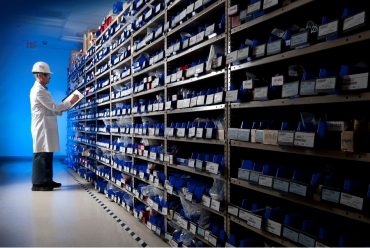
Supply chains will increasingly be guided by advanced digital technologies (most prominently, artificial intelligence) to enhance process automation and execution. With these cutting-edge tools, decision-making will blend harmoniously throughout the value chain.
Supply chains are a significant foundational component of most businesses’ lasting success. Thus, it’s unsurprising the supply chain management industry will be worth $45.2 billion by 2027.
Research shows that businesses that optimize their supply chains reduce related costs by 15%. They also cut their inventory levels in half. Their cash-to-cash cycles are three times faster than companies without optimized supply chains.
It’s not just about cost savings, though.
Nearly 80% of companies with optimized supply chains experience above-average revenue growth in their respective industries. We’re speaking of a distinctive competitive advantage that businesses must tap into.
We have found that supply chain inefficiencies, specifically supply chain disruptions, lead to a 7% drop in sales and up to a 5% jump in added expenses. Eliminating these issues is becoming increasingly crucial in a growingly competitive economy.
With your supply chain in ship-shape order, you can count on efficient, reliable, and repeatable operations that offer peace of mind. At the same time, the improvements trickle down throughout the rest of your organization.
Using the numbers we’ve discussed for context, consider how approximately 92% of companies investing in data and analytics achieved measurable value.
The marriage between analytics and supply chains involves two compatible parts, specifically in today’s rapidly evolving business landscape.
Leveraging Data and Analytics For Supply Chains
Data and analytics are everywhere in 2024 (and beyond). We hear about them in sports and how teams design strategies based on them. They’re also a massive influence in streaming services and podcast platforms—and we’re just scratching the surface.
However, it’s worth asking how analytics apply to supply chains. In what context do you use them?
Analytics in supply chains apply to processes and tools intended to parse, unify, and analyze data from several systems. Companies using the related tools seek them for procurement, processing, and distribution.
When their analytics are on point, companies enjoy a substantial leg up in fine-tuning a predictive supply chain.
Robust and successfully executed analytics processes enhance visibility and ensure more reliable forecasting. From there, decision-making regarding the supply chain dramatically improves, costly errors are avoided, and significant revenue increases tend to follow.
How to Leverage Data and Enhance Decision Making
Data and analytics can be game-changers for supply chains.
Broadly speaking, the related tools and processes enable companies to gather data from operations, logistics, sales, and customer feedback, calculate the numbers, and flag trends and patterns.
However, other specific approaches will determine whether your analytics and data will benefit your supply chain.
We’ll discuss some of those specific approaches to help set the stage for optimized supply chain analytics:
Define Your Key Performance Indicators
Your key performance indicators (KPIs) are the supply chain facets that drive efficiency and success.
Supply chain KPIs might include:
- On-time pickup
- On-time delivery
- Accessorial charges
- Dwell time
- Total landed costs
- Cost-to-serve
- Project cost variance
- Budget performance
- The carrying cost of inventory
- Inventory to sales ratio
- Days sales of inventory (DSI)
- Purchase order tracking
- Freight cost by weight (e.g., per pound or ton)
Utilize Real-Time Analytics
Gain near psychic vision into your supply chain visibility with real-time analytics tools.
Monitoring supply chain activities as they happen enables you to make proactive decisions, responding immediately to opportunities and potential snafus alike.
When data arrives in real-time, it prepares businesses for all supply chain outcomes, whether a disaster or a chance for positive changes that drive revenues.
Flag Inefficiencies and Bottlenecks
With insightfully implemented data analytics, bottlenecks and inefficiencies reveal themselves, and they do so promptly. Once equipped with these insights, you can correct course right away when encountering errors, delays, or resource constraints is possible.
Such swift improvements aren’t possible without real-time analytics flagging issues as they happen.
Bolster Demand Forecasting with Predictive and Prescriptive Analytics
Optimized demand forecasting ensures your production schedules, inventory levels, and resource allocation function like a well-oiled machine. With predictive analytics at your side, you remove much of the guesswork from this process. Shippers that embrace prescriptive analytics can gain additional benefits by leveraging tools that not only predict what may happen but also go a step further by suggesting the optimal course of action.
Identifying Processes to Automate
Automating processes drives productivity to previously unprecedented heights. Yet, you can’t automate supply chain components unthinkingly. Automating the incorrect process will have disastrous consequences.
Data analytics helps companies identify supply chain processes that can (and should) be automated, mitigating manual errors, freeing up employees for more vital work, and driving efficiency.
Other Crucial Components of Success
Here are a few more aspects to implement into your supply chain analytics:
- Supplier performance monitoring and tracking.
- Data visualization.
- Root cause analysis.
- Continual innovations and improvements.
See also: IoT and Digital Twins Take Supply Chains to a New Level
Why Is It Time to Embrace Supply Chain Analytics?
As of 2018, even before the pandemic, 96% of advanced supply chain companies used predictive analytics, while 85% used prescriptive analytics.
Six years have passed since then. During this time, we experienced a global emergency in COVID-19 that disrupted the supply chain and sent the industry into chaos. This experience only further highlighted the need for robust analytics in supply chains. More to the point, every supply chain needed to become advanced.
When you have the data at your fingertips, adjustments are far more seamless, no matter the obstacles that arise—even a pandemic. You can better predict the future while preventing the same errors made in the past.
What Does the Future Hold for Supply Chain Analytics?
Gartner speaks to a supply chain future guided by even more advanced digital technologies (most prominently, artificial intelligence) to enhance process automation and execution. With these growingly cutting-edge tools, decision-making will blend harmoniously throughout the value chain while employees benefit from more work design flexibility.
According to Gartner, the four primary future concerns for Chief Supply Chain Officers are as follows:
- Authentic ESG fulfillment.
- Commercial growth.
- Flexible work experiences.
- Real-time execution.
In the next six years, expect sustainability to grow in influence across end-to-end supply chain operations. Moreover, supply chain financing will also root itself in sustainability, focusing less on cost reduction and more on increased revenues.





























